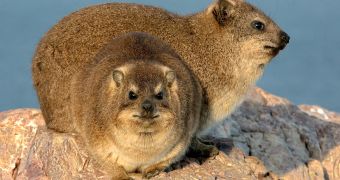The classical story is that dinosaurs dominated the Earth for hundreds of millions of years, until an asteroid collided into the Yucatan Peninsula and provoked 65 million years ago a mass extinction that permitted the ancestors of today's mammals to thrive.
The asteroid part did occur, but now, the dinosaurs' extinction is contested as playing a major role in the diversification of today's mammals.
An international team including University of Georgia Institute of Ecology Director John Gittleman has made a complete evolutionary tree for mammals that showed that the major diversification took place well after the asteroid collision, thus dinosaur dismissal did not play such a great role. "The previous evidence showed that we did see a die-off of the dinosaurs and an increase in the rise of the mammals roughly 65 million years ago," Gittleman said.
"But the fossil record, by its very nature, is patchy. We have found that when you fuse all of the molecular trees with the fossil evidence, the timing does not work. The preponderance of mammals really didn't take off until 10 to 15 million years after the demise of the dinosaurs."
Mammals had already begun to diversify long before the asteroid-linked extinction event 65 million years ago that killed non-avian dinosaurs. The study reveals two major spikes in the steady evolution of modern mammals, both independent of the dino wipe-out.
One occurred around 93 million years ago, well within the dinosaur era, when the major divisions of living mammals-placentals, marsupials and monotremes (like platypus) emerged.
Most of these mammals belonged to lineages that are either extinct or have dwindled drastically in numbers. "It was other groups of mammals, not those we see today, that took advantage of the extinction of the dinosaurs," said study team member Robin Beck of the University of New South Wales.
Because genetic changes (mutations) occur at a relatively constant pace, scientists can estimate molecular evolutionary trees of the species and how they diverged from their common ancestor by assessing the number of mutations.
Radiocarbon dating provides divergence times from the fossil record. Gittleman's team combined over 2,500 partial trees by employing molecular data and the fossil record to make the first virtually complete mammalian tree. "The end result is that the mammals we know today are actually quite old and just flew under the radar of everything that was out there, be they dinosaurs or now other 'archaic' mammals as well, for a lot longer than most people suspected," said lead-author Olaf Bininda-Emonds, now on a Heisenberg Scholarship at the University of Jena, Germany.
There was a small pulse of mammalian variation immediately after the dinosaur disappearance but most of those species vanished without leaving current descendants.
The real boom in mammal evolution occurred in the Eocene epoch, about 56 to 34 million years ago, when primates, rodents, modern carnivores and hoofed animals really took off.
The reasons for the mammalian golden age remain a puzzle but could be linked to a bout of global warming. "Extensive molecular data indicate our common mammalian roots have to go back 90 to 100 million years, if not more, but many paleontologists have been dubious of this claim given the lack of ancestral-looking fossils until about 50 to 55 million years ago," said Ross MacPhee of the American Museum of Natural History.
"This new work helps reconcile those differences. Now we know the ancestors of living mammal groups were there, but in very low numbers."
"If they found one rodent in the Cretaceous (144 million to 65 million years ago), it would be more interesting than this entire paper", said John Gatesy, a biologist at the University of California, Riverside. "That's one of the next big questions. Now that we have this complete tree, we can examine what ecological characteristics correlate with the upturn," Gittleman said.
The team wants to know how future extinctions could be avoided because two closely related mammals in two different zones of the world likely present similar traits, a risky factor for one species can also endanger its close relatives.
The team is currently focusing on a model that can predict the extinction risk of a species based on factors like body size, reproductive patterns and habitat needs. "We want to conserve, manage and protect the maximum amount of biodiversity. Knowledge of the past gives us insight about what to conserve for the future", Gittleman said.

 14 DAY TRIAL //
14 DAY TRIAL //